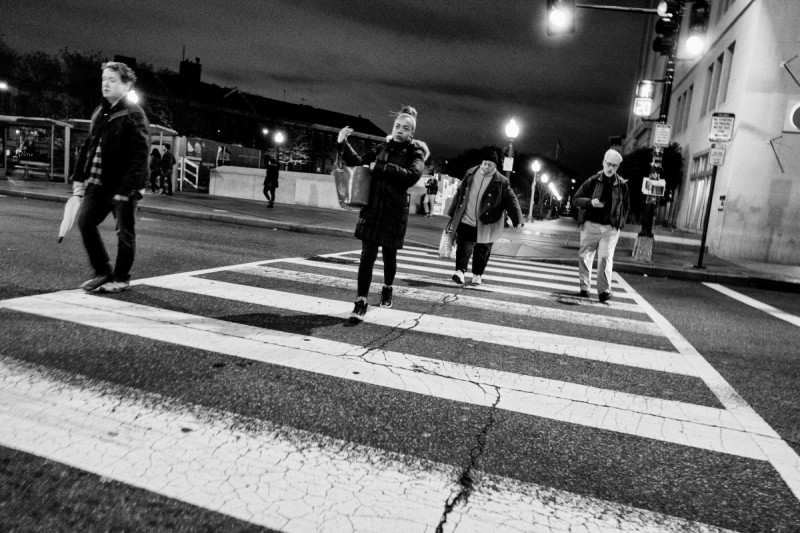The District’s streets are dangerous, and unjust, by design

Image by Mike Maguire licensed under Creative Commons.
On March 13 and 14 road safety advocates and leaders gathered to discuss the District's progress on Vision Zero, its committment to eliminating road deaths and serious injuries by 2024. The initiative is badly needed—we as a region, and as a nation, face a traffic safety crisis, particularly for people walking.
On average, drivers strike and kill 13 people walking per day nationwide. Between 2008 and 2017, 49,340 people were struck and killed while walking along or across our nation’s roads. These numbers are not only unacceptably high, they’re also, tragically, getting worse. 2016, 2017, and—based on preliminary data—2018 stand to be the three deadliest years on record for pedestrians in nearly three decades.
However, we’re not killing more people walking because we don’t know how to solve the problem —we’re killing more pedestrians because their safety is not our priority. Every two years, Smart Growth America publishes Dangerous by Design, a report that ranks the most dangerous states and regions to walk in based on federal data. Since the release of the previous edition of this report, four out of five states and metropolitan areas, including DC, grew more dangerous for people walking.
Over the past decade, the number of people killed while walking on our nation’s streets rose by 35% even as deaths among motor vehicle occupants declined by 6%. People walking and bicycling comprise an ever-increasing share of traffic deaths, and now account for one in six fatalities on our roads.
Vision Zero is an equity issue
The burden of this crisis is not equitably distributed. Older adults, people of color, and people walking in low-income communities are disproportionately killed by drivers while trying to walk along or across the street.
These disparities are even more pronounced here in DC where between 2008 and 2017, more than 100 people were killed while walking and another dozen people were killed while bicycling. Pedestrians and bicyclists account for almost half of all deaths on DC’s streets, and of those, almost 80% were Black or Latinx or both. Although, if you’ve spent some time exploring the interactive data on the city’s Vision Zero website, you wouldn’t know it. These data gloss over these glaring inequities with thinly veiled breakdowns of crashes by ward and no explicit mention whatsoever of racial or ethnic disparities.
Ward 8 in particular bears a disproportionate share of this burden—and could also benefit the most from tangible improvements to infrastructure. Almost a third of all traffic deaths in 2018 occurred in Ward 8, a lower income and predominantly black part of the city where rates of car ownership are lower than other wards. Decades of systematic underinvestment have left people in Ward 8 without safe, well-maintained places to bike or to walk along or across the street, while other (read: whiter, higher-income) wards benefit from greater—though still insufficient—investment in protected bike lanes, fresh-painted crosswalks, and other critical safety improvements.
No mention of Vision Zero in Bowser's State of the District speech
Local and regional organizations such as the Washington Area Bicycle Coalition (WABA) continue to advocate for Vision Zero, staging rallies outside the Wilson Building and calling for action in response to the city’s commitment to this initiative in the wake of rising traffic deaths.
Last week WABA assembled planners, engineers, public health professionals, elected officials, and advocates from throughout the region for its third annual Vision Zero summit packed with panel discussions on everything from data-driven planning to automated enforcement to equity in the face of historic segregation. DC Mayor Muriel Bowser made an appearance at the summit over lunch for a fireside chat, where she reaffirmed her commitment to Vision Zero and teased a big announcement forthcoming—one that she assured us we would all be very excited to hear.
Would she pledge massive investment in sidewalk repair and construction for Ward 7? Would she commit to redesigning Ward 8’s streets to slow down drivers and introduce intensive safety improvements for people walking and biking at intersections and mid-block crossings?
The big announcement during her State of the District Address the following Monday turned out to be the K Street transitway project in Ward 2 and the indefinite extension of free Circulator rides. While investment in more affordable, reliable transit is absolutely critical for the city, disappointingly there was no mention of Vision Zero nor meaningful steps to move us closer to zero deaths and resolve the unjust burden of this crisis on low-income communities of color.
If DC really hopes to prevent all traffic fatalities and serious injuries on its roadways, it needs to take meaningful action to proactively resolve these disparities. Establishing a Vision Zero Office to carry out this work and banning right turns on red in many intersections are great starts, but they’re not nearly enough. Until DC truly prioritizes the safety of people of color and of people walking and biking in its most vulnerable, under-invested communities, Vision Zero will remain forever beyond our grasp.
